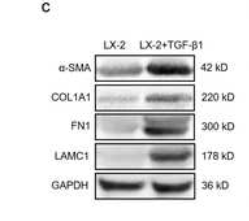LAMC1 Antibody - #DF3619
| Product: | LAMC1 Antibody |
| Catalog: | DF3619 |
| Description: | Rabbit polyclonal antibody to LAMC1 |
| Application: | WB IF/ICC |
| Cited expt.: | WB |
| Reactivity: | Human, Mouse, Rat |
| Prediction: | Pig, Zebrafish, Horse, Sheep, Dog |
| Mol.Wt.: | 178 KD; 178kD(Calculated). |
| Uniprot: | P11047 |
| RRID: | AB_2835991 |
Product Info
*The optimal dilutions should be determined by the end user.
*Tips:
WB: For western blot detection of denatured protein samples. IHC: For immunohistochemical detection of paraffin sections (IHC-p) or frozen sections (IHC-f) of tissue samples. IF/ICC: For immunofluorescence detection of cell samples. ELISA(peptide): For ELISA detection of antigenic peptide.
Cite Format: Affinity Biosciences Cat# DF3619, RRID:AB_2835991.
Fold/Unfold
LAMB2; lamc1; LAMC1_HUMAN; Laminin B2 chain; Laminin subunit gamma-1; Laminin, gamma 1 (formerly LAMB2); Laminin-1 subunit gamma; Laminin-10 subunit gamma; Laminin-11 subunit gamma; Laminin-2 subunit gamma; Laminin-3 subunit gamma; Laminin-4 subunit gamma; Laminin-6 subunit gamma; Laminin-7 subunit gamma; Laminin-8 subunit gamma; Laminin-9 subunit gamma; MGC87297; S-LAM gamma; S-laminin subunit gamma;
Immunogens
A synthesized peptide derived from human LAMC1, corresponding to a region within N-terminal amino acids.
- P11047 LAMC1_HUMAN:
- Protein BLAST With
- NCBI/
- ExPASy/
- Uniprot
MRGSHRAAPALRPRGRLWPVLAVLAAAAAAGCAQAAMDECTDEGGRPQRCMPEFVNAAFNVTVVATNTCGTPPEEYCVQTGVTGVTKSCHLCDAGQPHLQHGAAFLTDYNNQADTTWWQSQTMLAGVQYPSSINLTLHLGKAFDITYVRLKFHTSRPESFAIYKRTREDGPWIPYQYYSGSCENTYSKANRGFIRTGGDEQQALCTDEFSDISPLTGGNVAFSTLEGRPSAYNFDNSPVLQEWVTATDIRVTLNRLNTFGDEVFNDPKVLKSYYYAISDFAVGGRCKCNGHASECMKNEFDKLVCNCKHNTYGVDCEKCLPFFNDRPWRRATAESASECLPCDCNGRSQECYFDPELYRSTGHGGHCTNCQDNTDGAHCERCRENFFRLGNNEACSSCHCSPVGSLSTQCDSYGRCSCKPGVMGDKCDRCQPGFHSLTEAGCRPCSCDPSGSIDECNIETGRCVCKDNVEGFNCERCKPGFFNLESSNPRGCTPCFCFGHSSVCTNAVGYSVYSISSTFQIDEDGWRAEQRDGSEASLEWSSERQDIAVISDSYFPRYFIAPAKFLGKQVLSYGQNLSFSFRVDRRDTRLSAEDLVLEGAGLRVSVPLIAQGNSYPSETTVKYVFRLHEATDYPWRPALTPFEFQKLLNNLTSIKIRGTYSERSAGYLDDVTLASARPGPGVPATWVESCTCPVGYGGQFCEMCLSGYRRETPNLGPYSPCVLCACNGHSETCDPETGVCNCRDNTAGPHCEKCSDGYYGDSTAGTSSDCQPCPCPGGSSCAVVPKTKEVVCTNCPTGTTGKRCELCDDGYFGDPLGRNGPVRLCRLCQCSDNIDPNAVGNCNRLTGECLKCIYNTAGFYCDRCKDGFFGNPLAPNPADKCKACNCNLYGTMKQQSSCNPVTGQCECLPHVTGQDCGACDPGFYNLQSGQGCERCDCHALGSTNGQCDIRTGQCECQPGITGQHCERCEVNHFGFGPEGCKPCDCHPEGSLSLQCKDDGRCECREGFVGNRCDQCEENYFYNRSWPGCQECPACYRLVKDKVADHRVKLQELESLIANLGTGDEMVTDQAFEDRLKEAEREVMDLLREAQDVKDVDQNLMDRLQRVNNTLSSQISRLQNIRNTIEETGNLAEQARAHVENTERLIEIASRELEKAKVAAANVSVTQPESTGDPNNMTLLAEEARKLAERHKQEADDIVRVAKTANDTSTEAYNLLLRTLAGENQTAFEIEELNRKYEQAKNISQDLEKQAARVHEEAKRAGDKAVEIYASVAQLSPLDSETLENEANNIKMEAENLEQLIDQKLKDYEDLREDMRGKELEVKNLLEKGKTEQQTADQLLARADAAKALAEEAAKKGRDTLQEANDILNNLKDFDRRVNDNKTAAEEALRKIPAINQTITEANEKTREAQQALGSAAADATEAKNKAHEAERIASAVQKNATSTKAEAERTFAEVTDLDNEVNNMLKQLQEAEKELKRKQDDADQDMMMAGMASQAAQEAEINARKAKNSVTSLLSIINDLLEQLGQLDTVDLNKLNEIEGTLNKAKDEMKVSDLDRKVSDLENEAKKQEAAIMDYNRDIEEIMKDIRNLEDIRKTLPSGCFNTPSIEKP
Predictions
Score>80(red) has high confidence and is suggested to be used for WB detection. *The prediction model is mainly based on the alignment of immunogen sequences, the results are for reference only, not as the basis of quality assurance.
High(score>80) Medium(80>score>50) Low(score<50) No confidence
Research Backgrounds
Binding to cells via a high affinity receptor, laminin is thought to mediate the attachment, migration and organization of cells into tissues during embryonic development by interacting with other extracellular matrix components.
Secreted>Extracellular space>Extracellular matrix>Basement membrane.
Found in the basement membranes (major component).
The alpha-helical domains I and II are thought to interact with other laminin chains to form a coiled coil structure.
Domains VI and IV are globular.
Research Fields
· Cellular Processes > Cellular community - eukaryotes > Focal adhesion. (View pathway)
· Environmental Information Processing > Signal transduction > PI3K-Akt signaling pathway. (View pathway)
· Environmental Information Processing > Signaling molecules and interaction > ECM-receptor interaction. (View pathway)
· Human Diseases > Neurodegenerative diseases > Prion diseases.
· Human Diseases > Infectious diseases: Parasitic > Toxoplasmosis.
· Human Diseases > Infectious diseases: Parasitic > Amoebiasis.
· Human Diseases > Infectious diseases: Viral > Human papillomavirus infection.
· Human Diseases > Cancers: Overview > Pathways in cancer. (View pathway)
· Human Diseases > Cancers: Specific types > Small cell lung cancer. (View pathway)
References
Application: WB Species: Mouse Sample:
Restrictive clause
Affinity Biosciences tests all products strictly. Citations are provided as a resource for additional applications that have not been validated by Affinity Biosciences. Please choose the appropriate format for each application and consult Materials and Methods sections for additional details about the use of any product in these publications.
For Research Use Only.
Not for use in diagnostic or therapeutic procedures. Not for resale. Not for distribution without written consent. Affinity Biosciences will not be held responsible for patent infringement or other violations that may occur with the use of our products. Affinity Biosciences, Affinity Biosciences Logo and all other trademarks are the property of Affinity Biosciences LTD.
